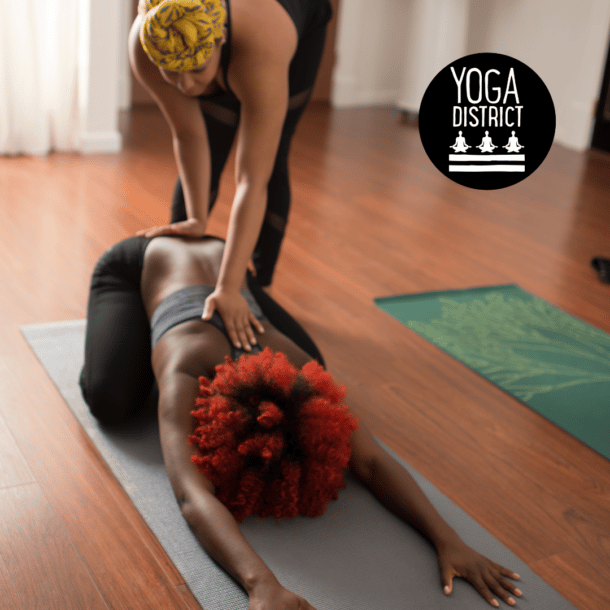
This month’s pose is Warrior I.
You likely experience it several times during a Flow (Vinyasa) yoga class.
Find out about Warrior I:
- benefits
- cues
- modifications
- variations
- contraindications
Warrior I (Sanskrit: Virabhadrasana I)
Pronunciation: veer-uh-buh-DRAHS-uh-nuh
Vira = Hero, Brave
Bhadra = Virtuous
Asana = Posture
Virabhadrasana = Virtuous Hero Posture
A Pose of Strength + Steadiness
Warrior I is a powerful grounded pose that requires a lot of concentration. As a foundational pose, many other poses build off of it during a yoga sequence. Warrior I involves strength, stability, and balance.
Disclaimer: If you have any medical concerns then talk with your doctor before practicing yoga. Practice within your own limits.
Benefits of Warrior I:
- Opens up the chest
- Enhances stability
- Strengthens the abdominal muscles, thighs, ankles, and back
- Helps with flexibility in the hips and shoulders
- This pose can be very therapeutic for people that experience sciatica
 Cues:
Cues:
1. Begin in downward dog.
2. Raise your left foot into three-legged dog.
3. Bring your left foot between your hands.
4. Ensure the back foot is at a 45 to 60 degree angle.
5. Ground the heel of the back foot into the mat.
6. Draw the front hip back and the back hip forward so that your hips are squared towards the front of the room.
7. Keep the front knee directly over the ankle.
8. Make sure to not overarch your low back.
9. Keep the gaze forward and chin parallel to the floor.
10. Press the shoulders away from one another to open the chest.
Modifications:
- Press the palms of the hands into the wall.
- This will help align your torso properly. Shorten your stance and place your hands on your hips.
- Place the arm of the front leg to your hip or back and raise the other arm over your head. Separate the arms if the shoulders rise up towards the ears.
- This will help your shoulders rest in a neutral position.
- If you can’t keep your back heel grounded, you can place a blanket under your heel.
Variations
If you have any issues with raising your arms or neck strain:
- – you can press your hands into the sides of your ribs
- – you can also use cactus arms instead of raising your arms straight up
Contraindications:
- Begin this pose with modifications if you have:
- knee issues
- hip issues
- shoulder pain
- low back pain
- high blood pressure
- heart disease
- history of stroke
- If you have neck problems then do not gaze up towards your hands
SOURCES:
Kaminoff, Leslie, and Amy Matthews. Yoga Anatomy, 2nd Edition. Human Kinetics, 2012.
Le Page, Joseph, and Lilian Le Page. Yoga Teachers’ Toolbox, 2nd Edition. Integrative Yoga Therapy, 2005.




